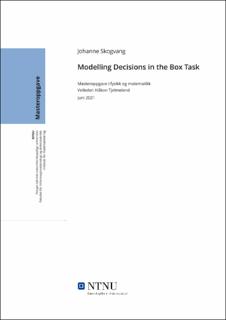| dc.description.abstract | Et av de viktigste symptomene på schizofreni er vrangforestillinger. Mange med dette symptomet har vist seg å trekke forhastede slutninger uten å ha nok informasjon, de har da har et 'jumping to conclusions' (JTC) bias. Bokstesten (the box task) har blitt foreslått å bruke for å finne ut om noen har et JTC bias. Da ser man tolv grå bokser i et rutenett. Man åpner en og en boks, og bak hver boks skjuler det seg en av to farger, rød eller blå. Deltakerne får beskjed om at en av fargene alltid er i majoritet og at de skal finne ut hvilken det er. I denne rapporten brukes to versjoner av bokstesten, én hvor man får åpne alle de tolv boksene og en annen hvor deltakerne får beskjed om at testen terminerer når en tilfeldig boks åpnes. Disse kalles henholdsvis ubegrenset og begrenset versjon. I denne rapporten finner vi en Ideell Observatør-løsning, hvor en Ideell Observatør er en deltaker som alltid tar optimale valg. Vi har data fra 76 personer som har gjort begge versjoner av bokstesten, og vi modellerer hvordan disse tar valg når de tar testen med en softmax-modell. Modellen inkluderer parameterne α, som representerer et lite tap man får hver gang en boks åpnes, β, som er det tapet man får hvis testen terminerer i den begrensete versjonen og η, som sier noe om hvor gode valg man tar. Sannsynligheten for at en boks er rød, Θ, har en apriorifordeling som inkluderer hyperparameterne γ og κ. Modellparameterne estimeres med sannsynlighetsmaksimering, og konfidensintervaller beregnes ved hjelp av parametrisk bootstrapping. Deretter ser vi på hvor sensitive resultatene er når vi forandrer på hyperparameterne i apriorifordelingen til Θ.
Modellen passer bra hvis deltakerne tar gunstige valg, men ikke fullt så bra hvis de tar dårlige valg. Lengden på konfidensintervallene til individene som tar optimale eller nesten optimale valg blir null. For disse deltakerne er derfor ikke parametrisk bootstrapping den beste måten å finne disse intervallene på. I den ubegrensede versjonen blir η påvirket lite når hyperparameterene forandres, mens α tenderer til å bli mindre for de minste hyperparameterene brukt her. I den begrensede versjonen, derimot, får mange deltakere lavere estimater for alle tre parametere. | |
| dc.description.abstract | Delusions are one of the main symptoms of schizophrenia, and delusion prone individuals have been linked to a 'jumping to conclusions' bias. That means drawing conclusions without having sufficient information. An information sampling task called the box task has been proposed to find if participants have this bias. In the box task, we have a grid of grey boxes that, when opened, either display the colour red or blue. Participants are informed that one colour is in the majority and that their task is to find out which one. We use two versions of the box task, one where the participants can open as many boxes as they want and another where the test terminates when they try to open a random box. These are called the unlimited and limited versions, respectively. In this report, we find an Ideal Observer solution of the box task, where an Ideal Observer is someone who would make the optimal choice each time a box is opened. We have data from 76 participants who have done both versions of the box task, and we define a model for how they make decisions using a softmax model. The model includes parameters, α, that is a minor loss or penalty a participant gets each time a box is opened, β, that is the loss we get if the test terminates in a limited trial and η, that is a measure of how good the decisions the participant make are. In the model, the probability that a box is red, Θ, has a prior distribution with hyperparameters γ and κ. We estimate the model parameters for each participant with maximum likelihood estimation and find confidence intervals using parametric bootstrapping. Finally, we look at the sensitivity to the hyperparameters in the prior distribution for Θ.
This model is a good fit for the participants who make good choices but not for those who make bad choices. Parametric bootstrapping makes the confidence intervals for the participants that make optimal, or close to optimal, choices have length zero, meaning that, for these participants, this is not the best choice of method for finding these intervals. Looking at the sensitivity in the unlimited case, we find that the values of η are not sensitive to the changes in the prior, whereas the values of α tend to be smaller with one of the priors. However, in the limited version, the model is sensitive to the changes in the prior and tend to estimate smaller values for all three parameters for the smallest values of the hyperparameters we use here. | |
